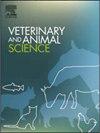ProAKAP4 concentration in fresh canine semen and its correlation with motility parameters
IF 1.9
Q2 AGRICULTURE, DAIRY & ANIMAL SCIENCE
引用次数: 0
Abstract
This study aimed to evaluate proAKAP4concentrations in canine fresh semen and to determine their correlation with sperm motility and fertility parameters. For this purpose, 26 ejaculates from 18 dogs were analyzed. Motility and kinetic parameters of the sperm-rich fractions were assessed by a computer assisted semen analyzer (Hamilton Thorne HT-IVOS II, USA). ProAKAP4 concentrations were measured (containing either the spermatic, urethral, or prostatic fraction) using the Dog 4MID® kit (4BioDx, France). In the spermatic fractions, on average, the proAKAP4 concentration was 17.08 ng/106spermatozoid (spz) with a total motility of 75.92 % and progressive motility of 58.08 %. Spearman test showed a positive correlation between proAKAP4 concentrations and the total motility (r = 0.584; p = 0.08), progressive motility (r = 0.6336; p = 0.0005), and the velocity parameters: VAP (r = 0.4178; p = 0.0337), VSL (r = 0.3919; p = 0.0477) and mainly VCL (r = 0.5266; p = 0.0057). For fertility monitoring, 5 ejaculates were used to perform artificial insemination (AI). The mean proAKAP4 concentration was 25.91 ng/106spz with an average total motility of 74.4 % and progressive motility of 53 %. Four female dogs were pregnant with litter sizes ranging from 4 to 11 puppies. To conclude, this is the first study presenting the significant correlation between proAKAP4 concentration and sperm motility parameters in dogs. Further investigations with a large number of animals are recommended to test the correlation between proAKAP4 and fertility parameters.
新鲜犬精液中 ProAKAP4 的浓度及其与运动参数的相关性
本研究旨在评估犬新鲜精液中proakap4的浓度,并确定其与精子活力和生育参数的相关性。为此,研究人员分析了18只狗的26次射精。通过计算机辅助精液分析仪(Hamilton Thorne HT-IVOS II, USA)评估富精子部分的运动和动力学参数。使用Dog 4MID®试剂盒(法国4BioDx公司)测定ProAKAP4浓度(包括精子、尿道或前列腺部分)。在精子中,proAKAP4浓度平均为17.08 ng/ 106spz,总运动力为75.92%,渐进运动力为58.08%。Spearman检验显示proAKAP4浓度与总运动性呈正相关(r = 0.584;P = 0.08),进行性运动(r = 0.6336;p = 0.0005),速度参数:VAP (r = 0.4178;p = 0.0337), VSL (r = 0.3919;p = 0.0477),以VCL为主(r = 0.5266;P = 0.0057)。用于生育监测,5次射精进行人工授精(AI)。proAKAP4平均浓度为25.91 ng/106spz,平均总运动性为74.4%,渐进运动性为53%。4只母狗怀孕,产仔数量从4到11只不等。综上所述,这是首次发现狗体内proAKAP4浓度与精子运动参数之间存在显著相关性的研究。建议对大量动物进行进一步的研究,以检验proAKAP4与生育参数的相关性。
本文章由计算机程序翻译,如有差异,请以英文原文为准。
求助全文
约1分钟内获得全文
求助全文
来源期刊

Veterinary and Animal Science
Veterinary-Veterinary (all)
CiteScore
3.50
自引率
0.00%
发文量
43
审稿时长
47 days
 求助内容:
求助内容: 应助结果提醒方式:
应助结果提醒方式:


